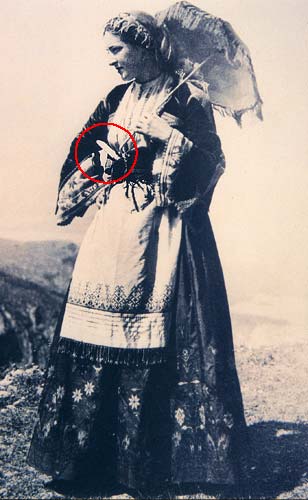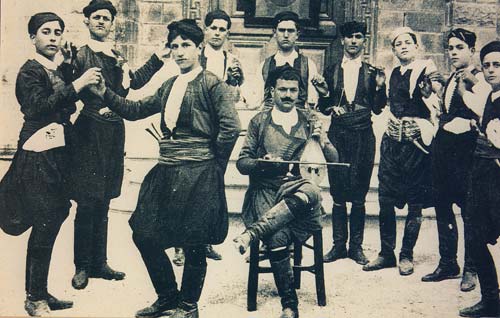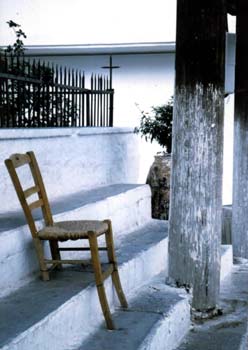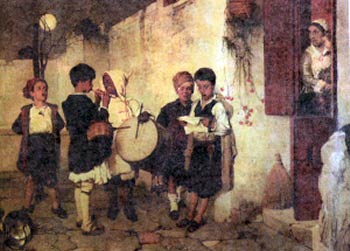The Cretan Dagger in Customs and Beliefs
Part 3
The importance of the Cretan dagger’s symbolic value in the social life of Crete survived even until recently.
One of the nuptial customs in Crete required from the future bride – groom to offer his fiancee, in addition to the other gifts, a small silver dagger, the argyrobounialaki. This small dagger, which was part of the Cretan women’s costume, was thereafter worn by the Cretan girl on her waist, tucked inside her long blue – red silk sash, exactly as men wore their own, in all balls and celebrations.

From a semiological point of view, the dagger indicated to other men that the girl was betrothed or married and that she belonged to one and only man.
As a symbolism, it reminded the girl herself that she ought to be devoted to her husband and that the price she would pay for any infidelity would be her own life. However, in addition to its symbolic significance, the dagger also had practical value, because the young Cretan woman would be able to defend herself and her dignity when in danger.
For the success of the wedding ritual and the stable foundation of the new family, Cretan customs prescribed earlier that a small black – hilted dagger be placed on the bride’s shoe before and during the wedding ceremony, so that the “spells” of those envying her fortune would not work.
Earlier, they used to believe in Crete that if the couple held a black – hilted dagger during the wedding ceremony, it would be able to counteract any “spells” that might have been cast on them aiming at the solution of the marriage.
Finally, after the wedding ceremony the newly – wed couple had to etch a cross on the threshold of their house with a black – hilted dagger, so that evil spirits would be prevented from entering and haunting it.
The symbolic significance of the dagger and its great metaphysical value in protecting humans against the fiendish powers of the invisible world and “ill – fated moments” was deeply rooted in Crete .
Tiny black – hilted daggers were used in manufacturing talismans for young children and talismans for protecting epileptics from the bad influence of the moon and the possessed from the pernicious influence of demons.
Furthermore, when a woman lost one of her children, she used to hang small black – hilted daggers with crosses etched on their hilts around her other children’s necks as talismans, so that the Grim Reaper would not take them too.
The Cretan Dagger and Magical Ceremonies
Daggers, always black – hilted, since black – hilted daggers were feared by the demons, played a leading part in the practice of magic in the sublunar world of sorcerers.
The sorcerer, master of love and hatred, in proceeding with his work of magic according to his wishes or those of the man or woman who had requested his assistance, used a black – hilted dagger in his spells and rituals of any nature.
In their effort to dominate over the powers of nature, to transgress against its known laws and to control the lives of humans with the help of demons, sorcerers used black – hilted daggers, with which they traced a circle on the ground and then poked it in its centre. Then they entered the circle and uttered some cryptic words and secret names. In this way they summoned the demons and ordered them, according to their wishes, protected from their malicious power inside the circle they had traced with their dagger. The dagger should not have been used in any other work before this procedure.
The tracing of the circle and the invocation of demons that followed constituted, according to tradition, the consummation of the sorcerer’s magic skills.
The tracing of the magic circle with black – hilted daggers was exercised by the island’s sorcerers mainly during their meetings with demons, called “davetia”.
The most typical description of the tracing of a magic circle with a black -hilted dagger in Crete for obtaining a magic purpose is provided by Nikos Politis in his description of the instruction of the lyra – player by the Fairies, so that he would be able to play the lyra with great virtuosity:

“Whoever wants to become a good lyra – player should go to an isolated crossroads at midnight. First he should trace a circle on the ground with a black – hilted dagger, then enter it, stay there and start playing the lyra. A little later the Fairies will come and start hanging around him. Their purpose is not good, they want to do him harm, but since they cannot enter the circle, which has been traced with a black – hilted dagger, they try to lure him out in every possible way. They use blarney, they sing him nice songs, they wheedle him in a thousand and one different ways, but if he is wise, he must remain calm and continue to play the lyra without leaving the circle. If they fail, they invite him out of the circle in order to teach him how to play the lyra better. He must refuse. Then they will ask him to give them the lyra. The lyra – player should give it, cautious to let his arm or other part of his body out of the circle, because it will be amputated or he will go insane.
Then a Fairy starts playing the lyra with great virtuosity and afterwards they return the lyra to him, hoping that he will be persuaded to leave the circle and they will be able to harm him”.
According to the description of Nikos Politis, the continuous interchange of the instrument between the Fairies and the lyra – player, without anyone of them passing the limits of the circle traced with the black – hilted dagger, continues all night long until the first cock crows. Then they ask him to give them something of his own and they promise to teach him how to play the lyra like them in return. The lyra – player usually gives them one of his nails and they in turn teach him how to play the lyra with great virtuosity and then disappear at daybreak.
For this reason, in earlier times, if a lyra player played his instrument with outstanding virtuosity, he used to say: “What do you think? I learnt to play the lyra at the crossroads”.
- The Cretan Dagger, Part 1: the knife of Crete
- The Cretan Dagger, Part 2: Description & manufacturing of the Cretan Dagger
- The Cretan Dagger, Part 3: The Cretan Dagger in manners, habits, popular beliefs and magical ceremonies
“The Cretan Dagger “
Nikos Vasilatos
Classic Editions
ISBN 960-220-470-2
tel. +30-210 3639418
email: N. Vasilatos
© explorecrete.com All Rights Reserved. Reproduction or copying without permission is prohibited.






